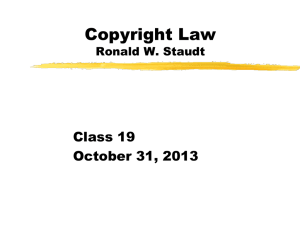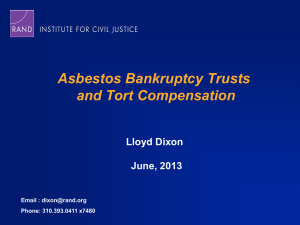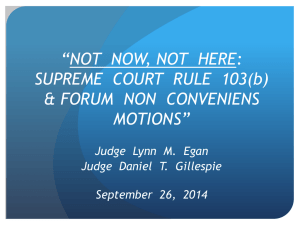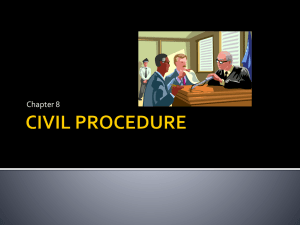Hydraulic Fracturing Litigation
advertisement
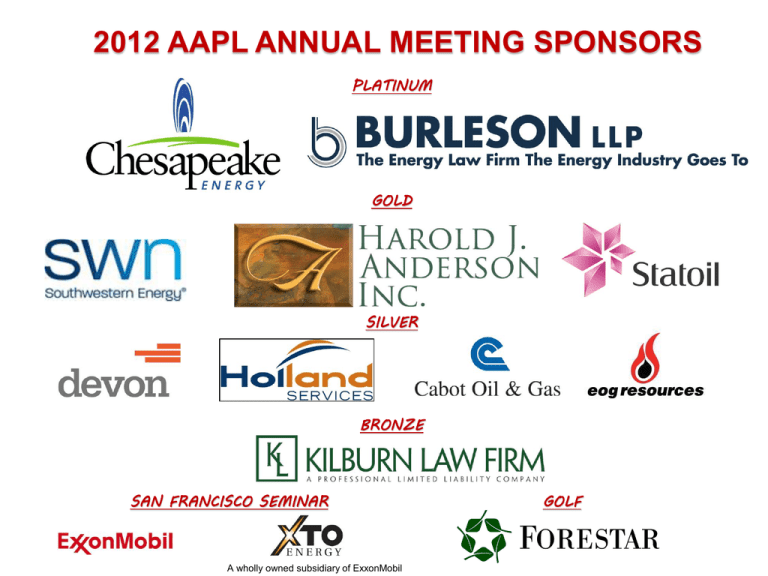
2012 AAPL ANNUAL MEETING SPONSORS PLATINUM GOLD SILVER BRONZE SAN FRANCISCO SEMINAR A wholly owned subsidiary of ExxonMobil GOLF LAWSUITS RELATED TO SHALE GAS DRILLING 58th Annual Meeting - San Francisco June 13-16, 2012 BEVERLEE E. SILVA JOSHUA BECKER 2 Hydraulic Fracturing Litigation • Two Broad Categories of Litigation – Private Interest Litigation • Litigation is initiated purportedly to protect the rights of an individual or group of individuals who claim to have suffered harm. – Public Interest and Regulatory Litigation • Litigation is initiated purportedly to protect the public at large, or to alter a legal regime of some kind. 3 Private Interest Litigation • • Litigation is initiated purportedly to protect the rights of an individual or group of individuals who claim to have suffered harm. Any combination of a broad range of claims have been asserted, including: − − − − − − − − − Nuisance Negligence Strict Liability Trespass Medical Monitoring and Similar Breach of Contract Fraud Assault Intentional Infliction of Emotional Distress 4 Nuisance – Two Types • Public Nuisance – An unreasonable interference with a right common to the public. – Turns on factors like whether the conduct involves a significant interference with the public health or safety, whether the conduct is unlawful, and whether the conduct is permanent or long-lasting. • Example: factory pollutes stream that town depends on for drinking water. – Could be a more difficult theory given the typical allegations of more localized exposure. 5 Nuisance – Two Types • Private Nuisance – Non-trespassory invasion of another’s interest in the private use and enjoyment of his or her land. • Example: We are neighbors, and I let dirty water from my irrigation ditch enter your property. 6 Private Nuisance Claims – Natural Gas Litigation • Berish v. Southwestern Energy Production Co. (M.D. Pa.) – Plaintiffs allege that gas production company caused spills and releases of chemicals that contaminated their property and drinking water. – Status: Discovery ongoing; Trial set for early 2013. • Fiorentino v. Cabot Oil & Gas Corp. (M.D. Pa.) – In connection with Dimock matter, plaintiffs allege that gas production company caused methane, HF chemicals, and waste to enter their water. – Status: Discovery ongoing. 7 Private Nuisance Claims – Natural Gas Litigation • Harris v. Devon Energy Prod. Co. (E.D. Tex.) – Plaintiffs allege that gas production company contaminated their well water with HF compounds. – Status: Case dismissed after Plaintiffs indicated tests showed their wells were not contaminated. • Hearn v. BHP Billiton Petroleum, Inc. (E.D. Ark.) – In a set of consolidated putative class actions, the Plaintiffs claim that the underground injection disposal of gas production waste caused earthquakes in Central Arkansas, which have interfered with the value and enjoyment of their land. – Status: Class discovery ongoing, and class certification hearing set for June 2012. Trial set for 2014. 8 Negligence and Gross Negligence • Negligence – – – – Duty; Breach of that duty; Causal connection between the conduct and the injury; and Actual damages. • Gross Negligence – Courts struggle with the precise definition, but it can be said to encompass a more extreme form of negligence. – A finding of gross negligence may enable an award of punitive damages, which may not be available for mere negligence. 9 Negligence and Gross Negligence Claims – Natural Gas Litigation • Baker v. Anschutz Exploration Corp. (W.D.N.Y.) – Plaintiffs claim that gas production companies breached their duty to prudently undertake gas production by failing to prevent and appropriately respond to spills and releases of chemicals. Plaintiffs further contend that the companies failed to properly notify them of the risks. – Status: Discovery is ongoing. 10 Negligence and Gross Negligence Claims – Natural Gas Litigation • Tucker v. Southwestern Energy Co. (E.D. Ark.) – Plaintiffs in this putative class action claim that hydraulic fracturing has contaminated their water. The basic allegation is that gas production caused the plaintiffs’ well water to smell like “cotton poison,” but it is unclear how the alleged contamination occurred. – Status: The judge considered recusing himself because he owns mineral rights, albeit outside the Fayetteville Shale where this dispute is centered. Ultimately, the parties declined to press the issue, and the judge remains on the case. Discovery is ongoing. 11 Strict Liability • Encompasses several theories, but the operative one in natural gas litigation is probably the abnormally dangerous theory: – One who carries on an abnormally dangerous activity is subject to liability for harm to the person, land, or chattels of another resulting from that activity, even though he or she exercised the utmost care to prevent the harm. Liability is, however, limited to the type of harm that makes the activity abnormally dangerous. 12 Strict Liability • Several factors influence whether an activity is considered abnormally dangerous: − − − − − The existence of a high degree of risk of great harm; The inability to eliminate the risk through reasonable care; Whether the activity is unusual; Whether the activity is inappropriate for the area; and The extent to which the activity’s dangerousness outweighs its value to the community. 13 Strict Liability Claims – Natural Gas Litigation • Berish v. Southwestern Energy Production Co. (M.D. Pa.) – Plaintiffs claim that gas drilling is, by definition, abnormally dangerous. – Status: In early 2011, the court declined to dismiss the strict liability claim prior to discovery, suggesting that theoretically natural gas by definition may be an abnormally dangerous activity. The court suggested, however, that the claim may be difficult to prove. • Hagy v. Equitable Production Co. (S.D. W.Va.) – Strict liability claim is based on generalized allegations that gas drilling is abnormally dangerous because of the “hazardous chemicals” and “combustible gases” involved. – Status: Case is set for trial in June 2012. 14 Negligence Per Se • Plaintiff must show that the defendant violated a statute, ordinance, or regulation designed to prevent harm. Plaintiff must also show that the violation actually caused him or her harm of the type the law was designed to prevent. – Example: Contractor builds roof in violation of building code, and the roof collapses, injuring an occupant. • Many opportunities for negligence per se claims, given the pervasiveness of regulations affecting the industry. 15 Negligence Per Se Claims – Natural Gas Litigation • Baker v. Anschutz Exploration Corp. (W.D.N.Y.) – Plaintiffs claim that production company violated various environmental and industrial regulations, causing damage to plaintiffs’ “homes and health.” – Status: Discovery is ongoing. • Boggs v. Landmark 4, LLC (N.D. Ohio) – Plaintiffs claim that, by discharging HF fluid and waste that affected their water supply and land, production company violated Ohio air and water regulations. – Status: Defense motion to dismiss pending. 16 Trespass • As applied to land, wrongful interference with one’s possessory rights in real property. • As applied to chattels (i.e., personal property), intentional interference with the possession of the chattel, causing injury. • Example: the theory for trespass to chattels (i.e., personal property) might be that a chemical spill injured livestock. 17 Trespass Claims – Natural Gas Litigation • Ginardi v. Frontier Gas Services, LLC (E.D. Ark.) – Plaintiffs claim that the placement of a large natural gas compressor station and associated equipment near the plaintiffs’ home caused them various injuries. – The theory underlying the trespass claim is that the air emissions (particulate matter, NOX, CO, VOCs, etc.) enter the plaintiffs’ property. They claim that they can recover for this “trespass” without being actually harmed by the emissions. – Status: The parties are litigating plaintiffs’ motion for summary judgment on the trespass claim. Essentially, plaintiffs are asking the court to rule, in advance of trial, that their trespass claim succeeds as a matter of law. There are several important issues, such as the question of whether airborne particles that do not cause damage, support a trespass claim. 18 Medical Monitoring • Essentially, where a plaintiff has been exposed to a substance that could cause health issues in the future, a medical monitoring claim allows the plaintiff to seek money to pay for periodic medical examinations to proactively monitor his or her health. • A plaintiff must show: – – – – Exposure greater than normal background levels; To a proven hazardous substance; Through the negligent actions of the defendant; and That a monitoring procedure for early detection exists, is different than normal health maintenance, and is reasonably necessary according to current scientific principles. 19 Medical Monitoring Claims – Natural Gas Litigation • These claims are common in natural gas litigation. Where available in a particular jurisdiction, they are tied to claims that rest on purported exposure to production-related chemicals, i.e., negligence/gross negligence, strict liability, etc. • Hagy v. Equitable Production Co. (S.D. W.Va.) – Plaintiffs claim that “spills and releases” contaminated their water, exposing them to the risk of future disease. – It is likely that the question of whether any exposure to chemicals was at sufficient dose to cause disease will be hotly contested at the June 2012 trial. Many chemicals associated with hydraulic fracturing have only been shown to be dangerous to animals at high doses, if at all. 20 State Environmental Regulations • Many plaintiffs are also alleging violations of state statutes and regulations. • One example is the Pennsylvania Hazardous Sites Cleanup Act 35 P.S. § 6020.101, et seq. – Establishes that citizens have a right to clean water and a healthy environment. – A person who is responsible for a release or threatened release of a hazardous substance is strictly liable for the resulting costs and damages. 21 State Environmental Regulations • Pennsylvania Hazardous Sites Cleanup Act – Fiorentino v. Cabot Oil & Gas Corp. and Gas Search Drilling Services Corp. (M.D. Pa.) • Plaintiffs are various landowners in the Dimock, Pennsylvania area who signed oil and gas leases with Cabot Oil and Gas Corporation. • Plaintiffs allege that the defendants’ hydraulic fracturing activities have caused hazardous substances to be released onto plaintiffs’ properties. • Status: Discovery is ongoing. 22 State Environmental Regulations • Pennsylvania Hazardous Sites Cleanup Act – Fiorentino v. Cabot Oil & Gas Corp. and Gas Search Drilling Services Corp. (M.D. Pa.) • Alleged contamination includes: » » » » Combustible gas released into the headspaces of water wells; Elevated levels of dissolved methane released into water wells; Natural gas released into fresh groundwater; Industrial and/or residual waste released into the ground or near plaintiffs’ homes and water wells; » Diesel fuel spilled onto ground; and » Drilling mud discharged into diversion ditches. 23 Restrictive Covenants • While not as authoritative as statutes or regulations, restrictive covenants contained in land deeds also must be followed. • Some plaintiffs have been able to use restrictive covenants to prevent companies from engaging in hydraulic fracturing activities on their land. 24 Restrictive Covenants • Weiden Lake Property Owners Assoc. v. Klansky and Cabot Oil & Gas Corp. (NY Sup. Ct.) – A New York landowner signed a lease with Cabot Oil & Gas Corporation allowing for drilling. – The property owners association filed suit against a landowner to establish that the restrictive covenants contained within the deed of his property prohibited the exploration and drilling for natural gas on his land. – The court agreed with the plaintiff, and held that the language of the restrictive covenant restricted parcels in the community to single family residential, agricultural, or recreational use only. 25 State Agency Decisions • Plaintiffs have also challenged decisions made by state environmental agencies • Carter v. Pennsylvania Department of Environmental Protection (Pa. Environmental Hearing Board) − After methane gas was found in water wells in the Dimock, Pennsylvania area, the Pennsylvania Department of Environmental Protection (DEP) ordered Cabot to establish escrow funds for the affected families, and to temporarily provide potable water to them. − After some time, the DEP subsequently found that Cabot could cease providing potable water to the residents. − Landowners have appealed the decision, and argue that Cabot should continue to provide them potable water. − Status: Stayed, pending resolution of Fiorentino v. Cabot and Gas Search Drilling Services Corp., a related case pending in US District Court for the Middle District of Pennsylvania. 26 Breach of Contract • A breach of contract occurs when a party to a contract has failed to perform an obligation as expected under the contract. • A breach may occur when a party: − Refuses to perform the contract; − Does something that the contract prohibits; and − Prevents the other party from performing its obligations. 27 Breach of Contract • Fiorentino v. Cabot Oil & Gas Corp. and Gas Search Drilling Services Corp. (M.D. Pa.) – Plaintiffs are various landowners in the Dimock, Pennsylvania area who allege that the defendants’ hydraulic fracturing activities caused the plaintiffs’ water wells to be contaminated. – Status: Discovery is ongoing. – Plaintiffs allege that defendants breached the contract by not fulfilling certain obligations of the oil and gas leases, including: • Keeping plaintiffs’ land, persons, and environment safe and undisturbed; • Testing plaintiffs’ water supply to ensure that it would not be adversely affected by the defendants’ operations; • Taking necessary steps to return the contaminated water supply to predrilling conditions; and • Payment of timely royalty checks in exchange for the extraction of gas. 28 Breach of Contract • Armstrong v. Chesapeake Appalachia, LLC (N.D.N.Y.) − Similar to Alexander v. Chesapeake Appalachia, LLC (N.D.N.Y.) − Allegations: • Plaintiffs allege that defendants violated their oil and gas leases by failing to provide plaintiffs with a release from their leases upon expiration of the lease term. • Plaintiffs argue this created a cloud on the title of the land, causing them to be unable to market their oil and gas interests. 29 Breach of Contract • Armstrong v. Chesapeake Appalachia, LLC (N.D.N.Y.) − Chesapeake claims that a qualifying event occurred, which allowed it to extend the term of the lease. • It claims that the lease allows it to extend the term if a qualifying event occurs, which includes the situation at hand. » Chesapeake claims that it has been unable to obtain a permit to drill on the land due to the state’s moratorium on drilling. o The governor announced that the Department of Environmental Conservation would not process any permit applications, pending environmental review of hydraulic fracturing. » The moratorium has prevented it from obtaining a drilling permit. − Status: Discovery is ongoing. 30 Fraudulent Misrepresentation • Fraudulent misrepresentation occurs when a false statement has been made, and ‒ The party making the statement is aware that it is false or disregards the possibility of it being false; ‒ The party makes such statements in order to induce the other party to enter into a contract; and ‒ The other party enters the contract as a result of the statement and consequently suffers a loss. • The misrepresentation can be intentional or negligent. 31 Fraudulent Misrepresentation • Fiorentino v. Cabot Oil & Gas Corp. and Gas Search Drilling Services Corp. (M.D. Pa.) − Plaintiffs are various landowners in the Dimock, Pennsylvania area who allege that defendants’ hydraulic fracturing activities caused their water wells to be contaminated. − Plaintiffs allege defendants made the following misrepresentations: • Drilling would have no impact on the water/land. • Any disturbances cased to the land and/or water during the drilling process would be remedied by Cabot and returned to pre-drilling conditions. • At most, plaintiffs would see a “little well head sticking out of the ground” and would “never know Cabot was even there.” 32 Fraudulent Misrepresentation • Fiorentino v. Cabot Oil & Gas Corp. and Gas Search Drilling Services Corp. (M.D. Pa.) − Alleged misrepresentations – cont’d • • • • Royalty payments would begin at a certain date. Royalty payments for gas drilling had reached “unprecedented heights” and that plaintiffs had to sign the leases on the spot in order to get a good deal. Plaintiffs should sign the lease because all of their neighbors already signed. Because their neighbors already signed leases, drilling would occur underneath their land regardless of whether they signed, so they “may as well get some financial compensation” out of it. ‒ Status: Discovery is ongoing. 33 Fraudulent Misrepresentation • Armstrong v. Chesapeake Appalachia, LLC (N.D.N.Y.) − Plaintiffs are landowners who signed oil and gas leases with Chesapeake in New York. − Plaintiffs allege that defendants falsely represented that: • The lease term was extended. • The lease contained a provision for an extension of the lease. • Defendants were unable to obtain permits, but plaintiffs allege that they were able to obtain them. − Status: Discovery is ongoing. 34 Fraudulent Misrepresentation • Alexander v. Chesapeake (N.D.N.Y.) − Plaintiffs are landowners who signed oil and gas leases with Chesapeake in New York. Chesapeake has attempted to extend their leases. − Plaintiffs claim they were led to believe: • The oil and gas leases presented to them had a specific term length. • No extension of lease could occur unless producible gas was obtained on the premises. • Plaintiffs claim there was no gas obtained. 35 Fraudulent Misrepresentation • Markowicz v. Shell Western Exploration and Production LP (M.D. Pa.) − In 1988, plaintiff and his mother each owned ½ interest in 46 acres of land in Wellsboro, Pennsylvania. − In 2005, an oil and gas lease was recorded, which was to be in effect for 5 years. − Plaintiff claims that even though his name is on the lease, he never signed it. He alleges that defendant induced his mother to sign the lease, and to sign both of their names. − Status: Discovery is ongoing. 36 Fraudulent Misrepresentation • Harris v. Devon Energy Production Co. (E.D. Tex.) − Plaintiffs own a tract of land in Denton County, Texas. It is on the geographic strata known as the Newark East Field. − Plaintiffs claim that soon after defendant commenced hydraulic fracturing activities, their ground water became polluted with a gray sediment. They allege that defendant told them the problem was related to defendant’s activities. − Upon plaintiffs’ request, the court dismissed the case due to test results showing that any alleged contamination was not toxic for human consumption. 37 Intentional Fraudulent Concealment • Fraudulent concealment occurs when a party: ‒ ‒ ‒ ‒ Concealed or suppressed a material fact of which it had knowledge; Concealed with the intention that the plaintiff be misled; The plaintiff was reasonably so misled; The material fact was not within reasonably diligent attention, observation, and judgment of the plaintiff; and – The plaintiff suffered damage as a result. • Similar to fraudulent misrepresentation. 38 Intentional Fraudulent Concealment • Boggs v Landmark 4 LLC (N.D. Ohio) − Plaintiffs are landowners in Ohio who entered into oil and gas leases with defendants. Plaintiffs allege that defendants’ hydraulic fracturing activities have contaminated their water wells. − Plaintiffs claim that defendants intentionally concealed material facts concerning the nature and magnitude of the exposure by the contaminants. − Status: Discovery is ongoing. 39 Deceptive Business Practices • Prohibits deceptive acts or practices in the conduct of any business, trade, or commerce or in the furnishing of any service. • Baker v. Anschutz Exploration Corp. (W.D.N.Y.) – Plaintiffs allege that their property is contaminated from defendant’s hydraulic fracturing activities. – Plaintiffs claim that defendant represented that its business practices did not pose an unusual threat to land or groundwater contamination in the areas surrounding its facilities. 40 Conversion • Occurs when one engages in an unauthorized act that deprives an owner of personal property without his or her consent. • Alexander v. Chesapeake Appalachia, LLC (N.D.N.Y.) – Plaintiffs, landowners in New York, entered into oil and gas leases with Central Appalachian Petroleum. – Plaintiffs allege that defendants improperly extended the lease terms, and therefore have wrongfully retained plaintiffs’ oil and gas rights. – Status: Discovery is ongoing. 41 Excess User • Cain v. XTO Energy (N.D. W. Va.) − Plaintiff is the owner of a surface tract of land. Another party owns the oil and gas rights to the land, and defendant is the lessee and natural gas operator. − Plaintiff alleges that XTO has plans to drill wells into not only the tract of reserved oil and gas underlying plaintiff’s land, but also into neighboring oil and gas tracts. − Plaintiff alleges that defendant’s use of plaintiff’s property is in excess of its property rights. − Status: Initial stages of discovery. 42 Assault • An assault occurs when one intentionally puts another person in reasonable apprehension of an imminent harmful or offensive contact. • Parr v. Aruba Petroleum, Inc. (TX) − Plaintiff owns approximately 40 acres of land in Decatur, Texas in Wise County. Defendant is engaged in hydraulic fracturing activities on nearby land. − Plaintiffs allege that defendant’s activities have contaminated plaintiffs’ land, livestock, and persons by the releases of hazardous gases, chemicals, and industrial wastes. − Plaintiffs allege that such occurrence is an assault for which the defendant is liable. − Status: Ongoing. Trial set for April 2013. 43 Battery • A battery occurs when one intentionally causes harmful or offensive contact with another’s person without that person’s consent. • Boggs v Landmark 4 LLC (N.D. Ohio) − Plaintiffs are landowners in Ohio who entered into oil and gas leases with defendants. Plaintiffs allege that defendants’ hydraulic fracturing has contaminated plaintiffs’ water wells. − Plaintiffs claim that defendants have committed battery by intentionally generating, or allowing the discharge of contaminants into the water wells, which have caused direct, harmful, and offensive contact with plaintiffs. − Status: Discovery is ongoing. 44 Intentional Infliction of Emotional Distress Intentional infliction of emotional distress occurs when: ‒ A defendant acts intentionally or recklessly; – The defendant’s conduct must be extreme and outrageous; and – The defendant’s conduct causes severe emotional distress. 45 Intentional Infliction of Emotional Distress • Parr v. Aruba Petroleum, Inc. (TX) − Plaintiff owns approximately 40 acres of land in Decatur, Texas in Wise County. Defendant is engaged in hydraulic fracturing on nearby land. − Plaintiffs allege that defendants’ activities have contaminated plaintiffs’ land, livestock, and persons by the releases of hazardous gases, chemicals, and industrial wastes. − Plaintiffs allege that they have suffered emotional distress from experiencing and witnessing each other’s decline in health, the death of their animals, and the environmental destruction of their property. 46 Fear of developing cancer • Baker v. Anschutz Exploration Corp. (W.D.N.Y.) − Plaintiffs are property owners or residents in Horseheads, New York. − Plaintiffs allege defendants’ gas wells contaminated their water wells. As a result, plaintiffs’ claim that they have a reasonable fear of developing cancer at some future date. − Status: Discovery is ongoing. 47 Public Interest and Regulatory Litigation • Challenges to Regulation • Suits to Require Environmental Reviews • Government Enforcement Actions • Suits regarding Local Regulation of Hydraulic Fracturing 48 Challenges to Regulation • Suits against government agency. • Brought by: − Regulated entity (industry). − Advocacy organizations. • Allegations: − Agency regulation is inconsistent with statute. − Agency violated procedural requirements. • APA challenge: − Final agency action. 49 Challenges to Regulation - Standing • Standing requirements: − Injury in fact; − Causal relationship; and − Redressability. • Associational standing requirements: − Members’ standing; − Organization’s purpose related to suit; and − Member participation not required. • Lack of standing is grounds for dismissal. 50 Independent Petroleum Association of America v. EPA (D.C. Cir.) • Parties: − Plaintiff: Independent Petroleum Association. − Defendant: EPA. • Factual background: − June 2010 EPA website announcement. − Requirements: • Injection permits. • Compliance with Class II well standards. • Allegations: ‒ EPA failed to follow required procedures before issuing rule. • APA. • SDWA. 51 Independent Petroleum Association of America v. EPA (D.C. Cir.) • Plaintiff’s standing: − On behalf of impacted members (associational). − Unable to participate in rulemaking (direct). • EPA Defenses: − Lack of standing – no redressability. − No final agency action. • Outcome: − Settlement and dismissal in February 2012. − EPA modified website language. − Issuance of EPA guidance. 52 Challenges to Regulation • Common outcome = agency agreement to issue regulation. − “Sue and settle” agreements. • Subject of recently proposed legislation (H.R. 3862). • Ex. Wildearth Guardians, et al. v. Jackson − Emissions standards for oil and gas sources under Clean Air Act. − EPA agreed to issue required standards. − Final rules were issued in April 2012. 53 Challenges to Regulation – Aggregation under CAA • Aggregation rule: − “Major source” permits. − Group of stationary sources can be aggregated to form a major source. − Aggregation is determined on a case-by-case basis. • Determinations challenged by: − Regulated entities, ex. Summit Petroleum Corp. − Environmental advocacy groups, ex. PennFuture. 54 Summit Petroleum Corporation v. EPA (6th Cir.) • Parties: − Plaintiff: Summit Petroleum Corporation. − Defendant: EPA. • Factual background: − Michigan DEQ asked EPA for determination on major source status of Summit’s facilities in Rosebush, Michigan. − EPA determined : • Summit plant and pipelines should be aggregated. • As aggregated, are a major source. 55 Summit Petroleum Corporation v. EPA (6th Cir.) • Allegations: ‒ EPA aggregation determination was error. • Determination ignored EPA’s own guidance. • Determination is inconsistent with EPA regulations. • EPA Defenses: − EPA guidance is non-binding general policy statement. − EPA determination is consistent with CAA. • Amicus Curiae: − American Petroleum Institute and American Exploration and Production Council filed amicus briefs in support of Summit. • Status: − Court heard oral argument on April 17, 2012; awaiting decision. 56 Citizens for Pennsylvania’s Future v. Ultra Resources, Inc. (M.D. Pa.) • Parties: − Plaintiff: PennFuture. − Defendant: Ultra Resources, Inc. • Factual background: − Ultra Resources’ Marshlands Play. − Construction permits from Pennsylvania DEP but no New Source Review permit. • Allegations: failure to obtain a New Source Review permit for Marshlands Play is CAA violation. − Seeking aggregation. 57 Citizens for Pennsylvania’s Future v. Ultra Resources, Inc. (M.D. Pa.) • Plaintiff’s standing: − Diminishment of PennFuture’s investment in prior litigation. − Impact on PennFuture members. • Ultra’s Defenses: − Impermissible collateral attack on state-issued permit. − Abstention and deference to state permitting regime. • Pennsylvania DEP filed amicus brief in support of Ultra Resources. • Status: − Ultra’s motion to dismiss for lack of jurisdiction is pending. − Potential impact of Summit decision. 58 Clean Water Action v. City of McKeesport (W.D. Pa.) • Citizen suit under Clean Water Act and Pennsylvania Clean Streams Law. • Parties: − − Plaintiffs: Clean Water Action and Three Rivers Waterkeeper. Defendant: Municipal Authority of City of McKeesport. • Factual background: − Publicly Owned Treatment Works (POTW) in McKeesport discharges wastewater into Monongahela River. − PA DEP ordered McKeesport POTW to limit acceptance of wastewater from oil and gas operations. − McKeesport POTW allegedly still accepting oil and gas wastewater. − McKeesport POTW wastewater allegedly contained pollutants characteristic of oil and gas wastewater. 59 Clean Water Action v. City of McKeesport (W.D. Pa.) • Allegations: − Unauthorized discharge of oil and gas wastewater. − Violation of CWA pretreatment standards. • Plaintiffs’ standing: − Members are impacted by alleged violations. − Plaintiffs are advocacy organizations focusing on water quality issues. • Outcome: − Parties have settled the case. − McKeesport POTW has agreed to stop accepting oil and gas wastewater. − If McKeesport POTW decides to accept oil and gas wastewater in the future, CWA permit will be required. 60 Suits to Require Environmental Reviews • Brought pursuant to National Environmental Policy Act (NEPA). • NEPA: − Applies only to federal agencies. • “Major” federal actions. − Requires evaluative process, but does not dictate outcome. − Agency NEPA regulations. • NEPA process: − Prepare Environmental Assessment (EA). − Issue Finding of No Significant Impact (FONSI) or prepare Environmental Impact Statement (EIS). − Use EA and/or EIS to take “hard look.” • Evaluate cumulative, direct, and indirect impacts. • Consider alternatives including no action. 61 Suits to Require Environmental Reviews • NEPA citizen suit provision: − Citizens and advocacy organizations. − Associational standing requirements. − APA requirements. • Must challenge “final agency action.” • General allegations: − Failure to take “hard look.” − EA and/or EIS incorrectly prepared. • Failure to consider all impacts and no action alternative. − FONSI issued in error; failure to prepare EIS. − Failure to comply with agency-specific NEPA regulations. 62 Ouachita Water League v. Henry (E.D. Ark.) • Parties: − Plaintiffs: Ouachita Water League, Newton County Wildlife Association, individual citizens. − Defendants: United States Forest Service, Department of Agriculture, Bureau of Land Management, U.S. Army Corps of Engineers, and Department of the Army. • Factual background: − USFS issued EIS and Land and Resource Management Plans for Ozark National Forest in 2005. − Natural gas drilling in the forest expected to increase; USFS found no need to supplement EIS. − BLM and ACE issued permits for Greers Ferry Lake without conducting EIS. 63 Ouachita Water League v. Henry (E.D. Ark.) • Allegations: − USFS failed to conduct new EIS or supplement existing EIS violated NEPA. − Defendants failed to analyze direct, indirect, and cumulative impacts. − Defendants denied plaintiffs opportunity to participate. • Plaintiffs’ standing: − Members are impacted by alleged violations. − Plaintiffs are advocacy organizations focusing on environmental conservation. • Defenses: − − − − Court lacks jurisdiction. No final agency action. Three survey permits are moot. NEPA does not require supplementation of EIS for land use plan. 64 Ouachita Water League v. Henry (E.D. Ark.) • Status: − Motion to dismiss for lack of jurisdiction is pending. − Jurisdictional discovery is allowed. − Plaintiffs’ response is due in September; decision is unlikely before Spring 2013. 65 Ozark Society v. USFS (E.D. Ark.) • Parties: − Plaintiffs: Ouachita Water League, Newton County Wildlife Association, individual citizens. − Defendants: United States Forest Service, Bureau of Land Management. • Factual background: − USFS issued EIS and Land and Resource Management Plans for Ozark National Forest in 2005. − Natural gas drilling in the forest expected to increase; USFS and BLM found no need to supplement EIS. − USFS and BLM have leased mineral rights and issued exploratory and production drilling permits. 66 Ozark Society v. USFS (E.D. Ark.) • Allegations: − Failure to take “hard look.” − Plaintiff is denied opportunity to participate. − Exception in Energy Policy Act of 2005 is inapplicable. • Plaintiffs’ standing: − Members are impacted by alleged violations. − Plaintiff is advocacy organization focusing on conservation, education, and recreation in the Ozark National Forest. • Defenses: − Court lacks jurisdiction. − No final agency action. − NEPA does not require supplementation of EIS for land use plan. 67 Ozark Society v. USFS (E.D. Ark.) • Status: − Court denied plaintiff’s motion for preliminary injunction: • USFS and BLM decision is not “major federal action” or final agency action. • There is no threat of irreparable harm. − Briefing on defendants’ motion to dismiss for lack of jurisdiction will be complete at the end of June. − Decision is likely this winter. 68 Center for Biological Diversity v. BLM (N.D. Cal.) • Parties: − Plaintiff: Center for Biological Diversity, Sierra Club. − Defendant: Bureau of Land Management. • Factual background: − BLM oil and gas lease sale in September 2011. − Sale relied on EA and FONSI issued by BLM in June 2011. • Allegations: − Failure to take “hard look.” − Failure to prepare EIS. − Violation of Mineral Leasing Act. 69 Center for Biological Diversity v. BLM (N.D. Cal.) • Plaintiffs’ standing: − Members are impacted by alleged violations. − Plaintiffs are advocacy organizations focusing on species and habitat preservation and environmental conservation. • Anticipated defenses: − Court lacks jurisdiction over MLA claim. − Plaintiffs lack standing to pursue MLA claim. − EA and FONSI are supported by the record. • Status: − Parties appear to be mediating case. − Summary judgment motions are due Summer/Fall 2012. 70 Wildearth Guardians v. BLM (IBLA) • Parties: − Plaintiffs: Wildearth Guardians and San Juan Citizens Alliance. − Defendant: Bureau of Land Management. • Factual background: − BLM allowed drilling in New Mexico’s Mancos shale. − BLM conducted EA. − BLM ultimately issued FONSI. 71 Wildearth Guardians v. BLM (IBLA) • Allegations: − BLM did not consider air impacts in EA. − EA did not analyze no action alternative. − BLM did not assess “unique impacts” of hydraulic fracturing. • Plaintiffs’ standing: − Administrative appeal requires: • Appellant is party to the case. • Appellant is adversely affected by decision. • Anticipated defenses: − EA and FONSI are supported by the record. 72 Coalition for Responsible Growth and Resource Conservation v. FERC (2d Cir.) • Parties: − Plaintiffs: Coalition for Responsible Growth and Resource Conservation, Damascus Citizens for Sustainability, and Sierra Club. − Defendant: Federal Energy Regulatory Commission. − Intervenor: Central New York Oil and Gas Company (CNYOG). • Factual background: − MARC I Hub Line Project is 39 mile natural gas pipeline and related facilities in Bradford, Lycoming, and Sullivan counties (Pennsylvania). − FERC issued certificate of public convenience and necessity to CNYOG for construction of MARC I Project. − FERC issued EA, and then FONSI. 73 Coalition for Responsible Growth and Resource Conservation v. FERC (2d Cir.) • Allegations: − FERC did not take “hard look.” • Failed to consider cumulative impacts. » Impact of Marcellus Shale development. • FERC should have prepared EIS. • FERC Defenses: − EA was comprehensive review. • Consideration of Marcellus Shale development was not required. − FONSI is supported by the record. • Status: − Awaiting oral argument and/or decision. 74 New York v. U.S. Army Corps of Engineers (E.D.N.Y.) • Parties: − Plaintiffs: State of New York, and, as consolidated, Delaware Riverkeeper Network, The Delaware Riverkeeper, Riverkeeper, Inc., The Hudson Riverkeeper, National Parks Conservation Association, Damascus Citizens for Sustainability, Inc. − Defendants: U.S. Army Corps of Engineers, U.S. Fish and Wildlife Service, National Park Service, Department of the Interior, EPA, Delaware River Basin Commission (DRBC). − Putative intervenors: American Petroleum Institute, Independent Petroleum Association of America, US Oil & Gas Association. 75 New York v. U.S. Army Corps of Engineers (E.D.N.Y.) • Factual background: − DRBC commissioners = Governors of four basin states and one federal representative. − DRBC will allow drilling in the Delaware River Basin. − No EIS was prepared. • Allegations: − DRBC is federal agency bound by NEPA. − Failure to prepare EIS is violation of NEPA. • Plaintiffs’ Standing − New York – proprietary capacity and parens patriae. − Other plaintiffs – direct and/or associational standing. 76 New York v. U.S. Army Corps of Engineers (E.D.N.Y.) • Anticipated defenses: − Lack of jurisdiction. − Lack of standing. − Inapplicability of NEPA. • Status: − Motions to dismiss for lack of jurisdiction are anticipated. − Motions to intervene are pending. − Oral argument on anticipated Motions to Dismiss is scheduled for July 24, 2012. 77 Likely outcomes of NEPA suits • Standing − Likely to be found. − Members’ allegations generally sufficient. • Merits − Deference to agencies. − Limits of NEPA. • Impact of threat of suit − Drives decision-making on front end. 78 Government Enforcement Actions • Federal, state, and local regulation of hydraulic fracturing. • Federal statutes: − Safe Drinking Water Act. − Clean Water Act. − Clean Air Act. • State regulation: − Federal statutes administered by states. − State corollaries. − Additional state statutes. 79 United States v. Range Production Company (N.D. Tex. & 5th Cir.) • Parties: − Plaintiff: United States (EPA). − Defendants: Range Production Company and Range Resources Corporation. • Factual background: − Emergency administrative order under SDWA. • Alleged well contamination. − EPA filed enforcement action. − Statutorily prohibition on challenging the order in enforcement action. − Range filed petition for review of order in the Fifth Circuit. 80 United States v. Range Production Company (N.D. Tex. & 5th Cir.) • EPA allegations: − Range did not comply with emergency order. • Range allegations: − Inadequate EPA investigation prior to issuance of order. − Order could be challenged in enforcement case. • Outcome: − District court stay. − Parties settled in March 2012. 81 New York State Department of Conservation v. U.S. Energy Development Corporation • Parties: − Plaintiff: New York State Department of Environmental Conservation (NYSDEC). − Defendant: U.S. Energy Development Corporation. • Factual background: − U.S. Energy drilling operations in Pennsylvania. • Area includes New York stream watershed. − Two orders on consent. − NYSDEC alleged: • Discharge from well operations. • Lack of erosion and sediment controls. 82 New York State Department of Conservation v. U.S. Energy Development Corporation • Allegations: − Violation of orders on consent and New York Environmental Conservation law. • Relief sought: − Order requiring compliance. − Civil penalties of $187,500. 83 Local Regulation of Hydraulic Fracturing • Local Regulation: − Zoning ordinances. − Bans on hydraulic fracturing. • Challenges to: − Municipal bans. − State legislation standardizing local regulation. 84 Challenges to Municipal Bans • Grounds for challenge: − Preemption by state law. • Ex. NY Oil, Gas & Solution Mining Law. • Northeast Natural Energy LLC v. City of Morgantown (Cir. Ct. W.Va.): − Monongalia County Circuit Court, West Virginia. − Ban struck down on preemption grounds. 85 Challenges to Municipal Bans • Anschutz Exploration Corp. v. Town of Dryden (Sup. Ct. Tompkins Cty.) and • Cooperstown Holstein Corp. v. Town of Middlefield (Sup. Ct. Otsego Cty.): − New York State. − Bans upheld. − State law preempts “how” of drilling regulation, not “where” of drilling. 86 Robinson Township v. Commonwealth of Pennsylvania (Pa. Commonwealth Court) • Parties: − Plaintiffs: Group of PA municipalities and Delaware Riverkeeper. − Defendants: Commonwealth of Pennsylvania and related state agencies. • Factual background: − Municipal plaintiffs have zoning ordinances restricting oil and gas drilling. − PA passed Act 13 in February 2012. • Restricts municipalities from regulating hydraulic fracturing. • Ordinances must be brought into compliance with statute. 87 Robinson Township v. Commonwealth of Pennsylvania (Pa. Commonwealth Court) • Allegations: − Act 13 violates PA Constitution. • Relief sought: − Preliminary injunction. − Declaratory judgment and permanent injunction. • Status: − Preliminary injunction granted in part; effective date of Act 13 stayed until mid-July 2012. − Motions to intervene were denied; amicus briefs have been accepted. − Motion to dismiss pending. 88 Thank you 89


